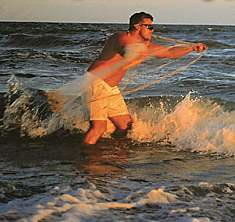|
Bull Run
 Beachfront 'Spin Doctors' are discovering the advantages of heavyweight spinning gear. Beachfront 'Spin Doctors' are discovering the advantages of heavyweight spinning gear.
By Larry Bozka
EAST MATAGORDA BEACH, 11:00 P.M.-The moon is full tonight, the
breeze light, out of the southeast and heavily laced with sand
and salt. Four heavy-duty spinning rigs rest at the water's edge,
supported by deeply-rooted sections of PVC pipe.
We've had a few runs. All, apparently, have been sharks-and big
ones at that. Finally, in desperation, Mark Davis and I switch
to 6-foot-long steel shock leaders.
I don't like using steel when fishing the beachfront for bull
reds; the stuff is so horribly visible. But tonight the water
is sandy, the full moon has yet to rise and the relative lack
of clarity-we hope-will compensate for the none-too-transparent
150-pound-test coated steel.
Bull redfish- early-fall spawners that instinctually converge
on coastal beachfront passes every year to offload huge cargoes
of eggs from massive and bulging ivory-white bellies-are fortunately
not deterred by off-colored water. It's the scent that counts,
so the 12/0 Eagle Claw circle hooks are baited with fresh chunks
of cut mullet that Davis captured earlier this evening in a fast-sinking
6-foot Fitec Pro Series "Super Spreader" 3/8-inch monofilament
cast net.
We sit in rusty lawn chairs, the truck stereo kicking out Robert
Earl Keen, Jr., Steve Earle and Tom Petty. The beat of the music
gently melds with the incessant lapping of the waves and the crackling
of a driftwood fire that warms the spirits and helps dry out surf-saturated
10X pants.
Halfway into the telling of a good fish story, Davis-chief PR
man for Shakespeare Fishing Tackle-bolts from his chair as the
big surfcasting rod on the far right assumes a forceful bend and
the 3800 Intrepid SS spinning reel begins to dole out line.
Five minutes pass, and the fish is still on. It's not a shark;
at least we don't think it is. Typical of large surf-run reds,
it's running parallel with the third sand bar some 100 yards offshore,
leading the body-builder down the beach.
We are, quite literally, happy campers. The tide has turned,
and the redfish, it appears, are starting to feed.
The surf has been choked with mullet since we arrived. However,
without at least some degree of tidal flow, all the baitfish in
the Gulf of Mexico usually won't trigger the bite. Now we have
not only abundant bait but also enough current to suction the
sand out from beneath our feet with frightening velocity. The
undertow is in high gear. Were it not for the wire-pronged, 6-ounce
"surf spider" weights, the fresh chunks of cut mullet
would have rolled back to the beach in a matter of minutes.
Davis is a big, muscular guy, but this particular fish has him
sweating like a man locked in a sauna. The stout, 11-foot 2-piece
surf rod-a BWS 1100 Ugly Stik-is exacting a heavy toll on the
running red, which is now well inside the second sand bar. The
reel, meanwhile, is slowly gaining line. Davis pumps in a few
cranks; the fish takes a few back. But despite its strength and
tenacity, the redfish is tiring.
The annual "bull redfish run" usually kicks off in
mid-August. After Labor Day, it outright ignites. The holiday
weekend was just over a week ago and we are, time-wise, in the
right place at the right time.
The "right place" part of the equation is considerably
more difficult to ascertain than the right time. I invariably
arrive at the beach at least a few hours before sunset-partly
because there's always the chance that I might find a sizable
school of surf-run speckled trout under working birds or popping
slicks and get the opportunity to toss hardware at what are usually
bigger-than-average specks, and partly because I need to visually
inspect and evaluate the terrain before setting up camp.
Peering through the amber lenses of a new pair of Costa Del Mar
wrap-around "Hammerheads," I clearly saw the break as
we were 4-wheeling our way down the beach about six hours ago.
In the surf, on the flats or far offshore, quality polarized
fishing glasses are imperative accessories. I'm not talking fashion
here; I'm talking function.
What to look for? Foremost, a "cut" in the bars-a discernible
break in the humped-up nearshore sand ridges that allows both
forage and game species to "cross the bar." Such cuts
provide baitfish a slight break from the intense currents, and
are sometimes-but not always-fairly easy to see. Where the water
color changes even slightly and the curl of the waves becomes
irregular, it's a fair bet that you've located such a spot.
Secondly, you seek out patches of shell well beyond the high-tide
waterline, it's likely out on the sand bars as well. Broken shell-innocuous
as it seems-is to redfish and other saltwater gamefish what hydrilla
and peppergrass are to largemouth bass.
Lastly-and it bears repeating-you find baitfish. Not just a random
jumping mullet, mind you, but a concentrated pod of active forage
fish.
continued
page 1 / page 2
| 




